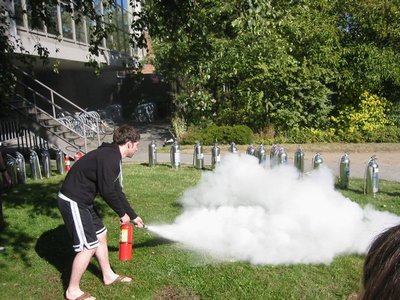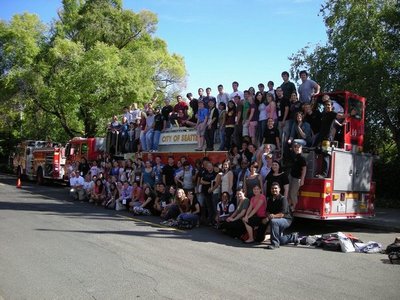October 9, 2008
Resident advisers get hands-on practice in fire safety
Thick smoke clouds a first-floor corridor of Terry Hall. A student squints her eyes in the haze, moving slowly through the hallway in search of a neon-green exit sign. She spots one with relief — she is safe.
Not that she was in any real danger to begin with. A theatrical smoke machine, rather than a dorm fire, is the source of the haze, and the student is a resident adviser (RA) participating in the UW’s first RA Fire Academy. The “smoke corridor” simulation is just one of the training exercises resident advisers completed during the two-day academy in September, which was created by the Department of Environmental Health & Safety (EH&S) and the Seattle Fire Department to educate RAs about fire safety and evacuation procedures.
About 110 RAs from campus residence halls and apartments participated in the training, which included classroom sessions like “General Fire Safety,” taught by the Seattle Fire Department, as well as “Fire Prevention” and “Dorm-Specific Evacuation Procedures,” taught by program lead and Fire Safety Engineer Anne Donegan.
“We partnered with [UW] Housing and Seattle Fire to develop the curriculum for this event,” said Mark Murray, manager of EH&S’s Building & Fire Safety Office. “Our goal was to develop a program that would be educational and fun, and I believe we met that goal.”
EH&S developed the RA Fire Academy this year in response to a growing national effort to improve fire safety at universities, Murray said. In August, President Bush signed into law the Higher Education Act, which contains provisions from the Campus Fire Safety Right-to-Know Act. The provisions will require colleges and universities to submit annual fire safety reports about student housing to the U.S. secretary of state and to make the information available to the public.
It didn’t take a law to get the UW moving on safely-equipped residence halls, however.
“Housing has been a great partner and very progressive in fire safety,” Murray said. “A program to voluntarily provide fire sprinklers in the residence halls was completed several years ago and fire alarm system and other safety upgrades are ongoing.”
The Seattle Fire Department had also encouraged EH&S to better prepare RAs for fire emergencies, said Murray. The fire department can do its job more quickly and efficiently if RAs know how to help reduce false alarms, improve evacuation procedures and communicate information about emergency situations to responders.
The RA Fire Academy was inspired by the University of Colorado at Boulder’s Residence Life Fire Academy, which is in its eighth year and serves as a national model for residence hall fire safety training. EH&S borrowed from CU’s program in developing practical exercises like the smoke-filled corridor.
According to Murray, RAs had the most fun completing hands-on activities like that one. In addition to navigating the smoke-filled corridor, RAs tested water fire extinguishers in the grass outside of Terry-Lander and learned about other types of extinguishers. Although the RAs didn’t extinguish a real fire, they did learn how to pull the extinguisher’s pin and practice a sweeping motion with the spray. RAs were also put to the test during a “hazard hunt,” in which they were asked to identify 21 housing-contract or fire-code violations in two mock dorm rooms, a study room and a corridor. Murray said the RAs did very well and found most of the violations, including candles and space heaters, which are important to recognize for fire prevention.
The academy’s practical exercises were valuable tools in addition to the classroom courses, said Murray. “I think it’s educational, you remember it better and it’s just more fun than sitting in a class the whole time.”
EH&S plans to make the RA Fire Academy an annual event and perhaps integrate additional emergency training, like earthquake procedures, into future sessions.




